#Olmsted Point
Text
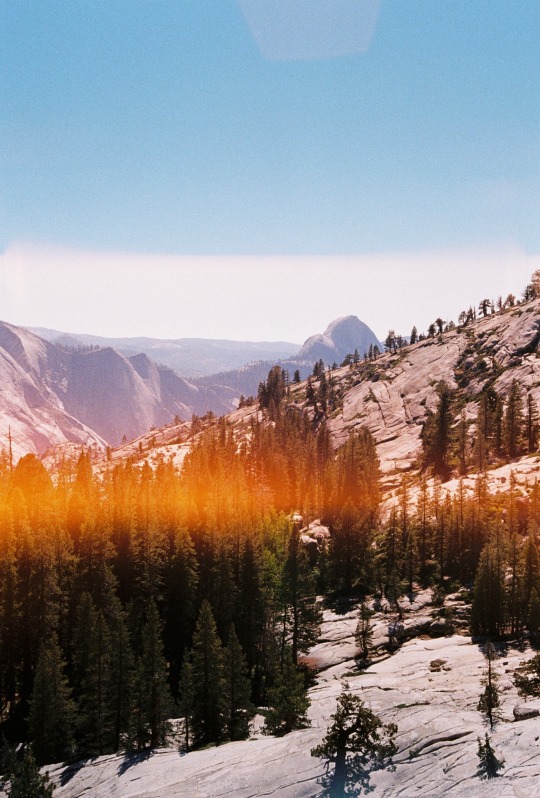
Half Dome from Olmsted Point
#holy cannoli these rolls are amazing#my film#35mm film#film photography#stay broke shoot film#35mm#film is not dead#canon ae1#california#Yosemite#Yosemite National park#half dome#tioga rd#Olmsted point#photographers on tumblr#light leaks
20 notes
·
View notes
Photo
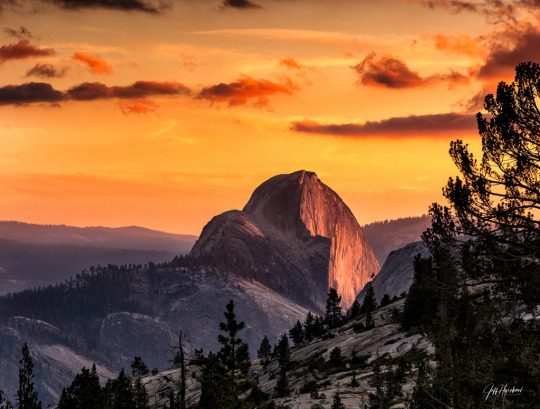
“Olmsted Point Sunset”
Location: Yosemite National Park, California.
by Jeff Harshaw
#jeff harshaw#photographer#olmsted point#sunset#landscape#yosemite national park#california#nature#mountains
32 notes
·
View notes
Photo

A Hard Place
What do you think about my pic?
#Yosemite National Park#granite#Sierra Nevada#Olmsted Point#rock#tree#fir#pine#dead tree#original photography#summer 2022#vacation#USA#travel#tourist attraction#landmark#landscape#countryside#flora#nature#bush#photo of the day#California#West Coast#What do you think about my pic?#rock formation
18 notes
·
View notes
Text
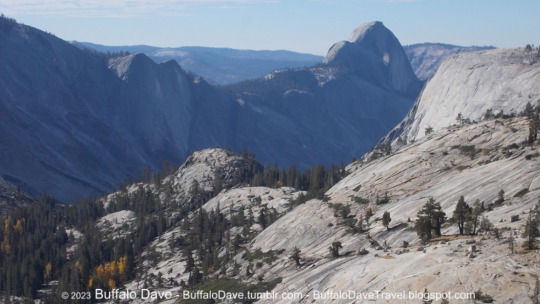




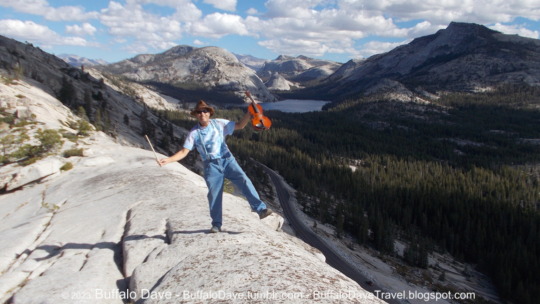
Yosemite National Park on top of dome above Olmsted Point - looking down to Half Dome and looking down toward Tenaya Lake
Buffalo Dave is fiddling!
pictures taken October 16 through 28 2023
0 notes
Text
The Mall

The Mall in Central Park is a famous and iconic feature of this renowned urban park located in the heart of Manhattan, New York City. It is a tree-lined promenade, often described as a "grand boulevard," that stretches for approximately 40 feet wide and 0.25 miles long. The Mall runs through the center of Central Park, offering a picturesque and serene setting for visitors. Here are some key details about The Mall:
Design and Landscape: The Mall was designed in the 1850s by the park's creators, landscape architects Frederick Law Olmsted and Calvert Vaux. It was intended to provide a peaceful and contemplative walkway that contrasts with the surrounding bustling city streets. The design includes a double row of American elm trees that create a leafy canopy overhead.
Scenic Beauty: The most striking feature of The Mall is its canopy of American elm trees, which arch over the pathway, creating a natural tunnel. The lush green canopy provides shade during the summer months and a stunning display of autumn foliage in the fall.
Historical Significance: The Mall is one of the original features of Central Park, dating back to the park's inception in the 19th century. Its historical significance lies in its role as a tranquil retreat within the bustling city, fulfilling the vision of Olmsted and Vaux.
Literary and Cultural Associations: The Mall has been featured in numerous films, television shows, and works of literature, adding to its cultural significance. It often serves as a backdrop for romantic scenes, leisurely strolls, and outdoor performances.
Statues and Sculptures: At the southern end of The Mall stands a statue of Christopher Columbus, unveiled in 1892. The Mall also includes statues of famous literary figures, such as William Shakespeare and Sir Walter Scott, as well as plaques featuring quotes from their works.
Activities and Events: Throughout the year, The Mall hosts a variety of events and activities. These can include art installations, concerts, outdoor performances, and cultural festivals. The pathway is often filled with musicians, artists, and street performers showcasing their talents.
Wedding Photography: Due to its romantic atmosphere and picturesque setting, The Mall is a popular location for wedding and engagement photography. Many couples choose to capture their special moments amid the elegant backdrop of the tree-lined promenade.
Four Seasons: The Mall offers a different experience in each season. In the spring, the elm trees sprout new leaves, creating a lush green canopy. In the fall, the changing leaves create a breathtaking display of autumn colors. During the winter, The Mall can be particularly enchanting when covered in snow.
Access and Location: The Mall is easily accessible by foot from various points within Central Park, making it a central and popular destination for park visitors. It is located near other notable landmarks such as Bethesda Terrace, the Central Park Zoo, and the Central Park Conservatory Garden.
Artistic Inspiration: The Mall has been a source of inspiration for countless artists, photographers, and writers. The atmospheric beauty of the tree-lined pathway and the changing seasons make it a captivating subject for creative expression.
Fitness and Recreation: While The Mall is primarily known for its leisurely strolls and cultural activities, it also provides an excellent space for various recreational activities, including jogging, yoga, and tai chi. The wide pathway and serene surroundings make it an ideal place for outdoor exercise.
Wedding Ceremonies: Beyond photography, The Mall is a popular choice for outdoor wedding ceremonies due to its romantic ambiance and picturesque backdrop. Couples often choose to exchange vows beneath the elegant canopy of elm trees.
Cross-Country Skiing: During the winter months when Central Park is covered in snow, The Mall transforms into a cross-country skiing destination. It offers a serene and snow-covered landscape for winter sports enthusiasts.
Quiet Reflection: Amidst the activities and events, The Mall provides moments of quiet reflection. Many visitors come here to find solitude, read a book, or simply enjoy a peaceful pause from the demands of city life.
Birdwatching: Central Park is a haven for birdwatchers, and The Mall is no exception. The combination of trees and open space attracts a variety of bird species, making it an excellent spot for birdwatching.
Educational Opportunities: The Mall's natural setting and historical significance provide opportunities for educational programs and guided tours. Visitors can learn about the park's history, ecology, and the significance of its design.
Horse-Drawn Carriages: Visitors can often spot horse-drawn carriages offering rides along The Mall and other parts of Central Park. It's a charming and nostalgic way to explore the park while taking in the scenic beauty.
Public Art Installations: Central Park frequently hosts temporary art installations, and The Mall is no exception. These installations can include sculptures, art exhibitions, and interactive displays, adding an artistic dimension to the natural surroundings.
Access: The Mall is wheelchair and stroller accessible, ensuring that visitors of all mobility levels can enjoy this iconic feature of Central Park.
In summary, The Mall in Central Park is a multifaceted destination that caters to a wide range of interests and experiences. Its natural beauty, cultural significance, and seasonal transformations make it a beloved and enduring part of Central Park's charm, providing both New Yorkers and visitors with a tranquil and enchanting urban escape.
#The Mall#New York City#new york#newyork#New-York#nyc#NY#manhattan#urban#city#USA#buildings#visit-new-york.tumblr.com#outdoors#journey#street#architecture#travel
184 notes
·
View notes
Text
BIPOC autistic people, content creators, blogs, and pages!
Okay...
This post was one that I was unsure how to write. I'm white and I am very aware of my privilege.
I wanted today's post to highlight and center the voices of autistic BIPOC individuals and honestly, I couldn't just talk about a few. I wanted to put as many names out here for people to follow.
For those who want to follow and learn and for those who need to find these wonderful people in their community.
When researching and working on my list, I came across a post made by Autistic, Typing in 2019 as they had made a list of Autistic Black/ Indigenous/ People of Color & Latinx Advocates to follow.
So today's post is a link to this amazing individual's link, https://www.faceook.com/share/p/VMWG2wURiVWuTP2r/
This link contains all their hard work and emotional labour, a comments section FILLED with people adding others or themselves to the list, as well as a google doc form to add/ edit/ remove autistic creators. So please, if you are one, go fill it out and have yourself added to the list!
Below are some people/ creators/ pages that I thought should be mentioned. I tried to just add the ones I didn’t see listed, but I know there is overlap and tried to point those ones out.
And PLEASE send me any others! I want to follow as many as I can.
Famous People
Anita Cameron- one of the original disability rights activists of the US.
Angela Weddle- artist (mentioned on the post)
Dr. Sarai Pahla- MD and medical translator
Dr. Angel Durr- CEO of DataReady DFW
Burnett Grant- senior lab tech at ZoomEssence Inc
Bernard Grant- Phd in English
Stephan Wiltshire- architectural artist
Lauraen-Rocelle Fernandez- Founder of Mask Off
Michael Buckholtz- music producer for acts such as MC Hammer
Jade Logan- comic artist
Elise Nicole Bowen- music composer who can be found on spotify
Avery Ahmer- tik tok influencer who talks about autism
Kayla Smith- Black Autistic Disability Rights Advocate and creator of #AutisticBlackPride
Kris Young- writer and blogger at Black Neuroqueer Punk (mentioned on the post)
Jackie Pilgrim- Board of NAMI
Armani Williams- professional Nascar driver
Morenike Giwa Onaiwu- advocate and public speaker co-edited All The Weight of Our Dreams and Sincerely Your Autistic Child (mentioned on the post)
Michael Fuller- music prodigy
Melissa Simmons- founder of MisTaught and the creator of Black History Month for Dummies & White Teachers (mentioned on the post)
Lamar Hardwick- the Autism Pastor. Writer and advocate (mentioned on the post)
Kambel Smith- artist known for complex architecture sculptures
Ronaldo Bryd- artist
Ikea “Syance” Wilson- artist and musician
Kris McElroy- writer, artist, and advocate
Talia Grant- first female actress who is autistic to land a mainstream role on British television
Kalin Bennett- first autistic person to receive a division 1 scholarship to play basketball
Tom Wiggins- former enslaved person who was an amazing musician
John Howard- martial arts competitor/ MMA fighter
Morgan Harper Nichols- storyteller and influencer
Questlove- musician and songwriter and collaborator for Disney Jr “Rise Up, Sing Out”
Lois Curtis- artist and plaintiff in the 1999 Olmsted Supreme Court Decision
Tyla Grant- found of Black and Neurodivergent (BAND) and host of the one percent podcast
Nik Sanchez- actor
Benjamin Banneker- naturalist and mathmetician
Talisha Johnson- writer and director of Too Autistic for Black
Joshua Beckford- child prodigy and youngest person to be admitted to Oxford at 6
Breanna Cook- Paralympic athlete
Creators
Marcela Collier @highimpactclub
Black Neurodiversity @blackneurodiversity
Autistic Black Woman @autisticblackwoman
Ryse @teachingwithmxt
Caro @disrupt_yuh_feed
Jessie @momma_lips
Nadia @autisticblackgirl
Kayla Smith @BeingKaylaSmith
Tiffany Joseph @nigh.functioning.autism (mentioned on the post)
Tiffany Hammond @fidgets.and.fries (mentioned on the post)
Lauren Melissa Ellzey @autienelle
La Fille Dani @myneurotype
Tim Boy @blackinfinityking (mentioned on the post under previous tag name @BlackAutisticKing)
Raven Derose @confidencewithrae
Danielle @zelue
Ahylaysia @ahlaysia
Rosalie Babette @theautisticgiraffe
Dr. Kofi @autisticallykofi
Jonteugbeye @jonteugbeye
Nia Patterson @thefriendineverwanted
Anansi @dreadfulrebel4x
Gianna Rose @usagi_rose_universe
M’Nda @melaninmaven97
Lina’s brain @ndwellness
Pages
The Activistic Autistic
The Art of Autism
Fidgets and Fries (mentioned on the post)
Not Your Mama’s Autism
The Kisha Project
Autism in Black
Neurodivergent Rebel
Black Neuroqueer Punk (mentioned on the post)
The Color of Autism
Sincerely Your Autistic Child
NeuroClastic- PLEASE pass along their post A Letter to Black and Indigenous Autistic Teens
Autistic, Typing- They have the amazing list of Autistic BIPOC Advocates here!!
Morenike GO
Black Autistic Lives Matter
Autistic People of Color Fund
Autistic People Of Color, Indigenous People, and Mixed-Race People - this is a private FB group highly recommended I can not comment on it
Neurodiverent Black Women- another private FB group recommended but I can not comment on it
Other Amazing Neurodiverse People
Simone Biles- olympic gymnast ad most decorated gymnast with 32 metals
Amada Gorman- youngest inaugural poet in US History
Clary Chambers- founder and CEO of SparkClarity
Solange Knowles- singer and actress
Harry Belafonte- singer, songwriter, actor. First Black person to win an Emmy.
Maya Angelou- poet and activist. Write “I know why the caged bird sings” and the poem “On the Pulse of the Morning” that was read at the 1993 presidential inauguration
Danny Glover- actor, director, activist. Prominent roles in Lethal Weapon, The Color Purple, and Angels in the Outfield
Octavia Spencer- actress, author, producer. Worked on The Help.
Brandon Marshall- former NFL player
Kelly Rowland- singer, songwriter, actress and member of Destiny’s Child
Jumaane Williams- politician and activist in New York City
Magic Johnson- former professional basketball player and one of the greatest 50 players of NBA
Clarence Page- journalist who has won a Pulitzer Prize
Mohammed Ali- professional boxer and activist
Black Girl, Lost Keys
Tumi Sotire @TheBlackDyspraxic




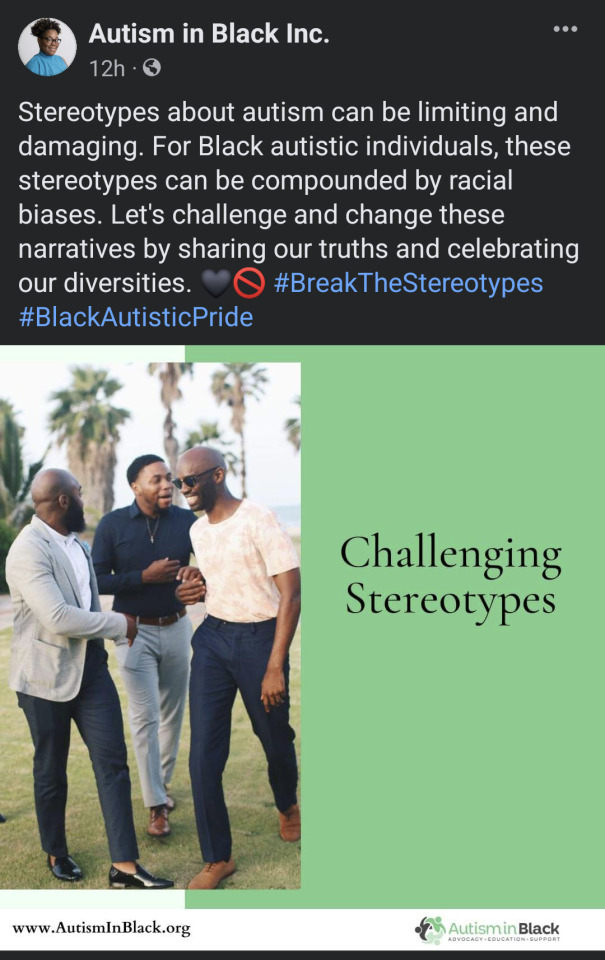
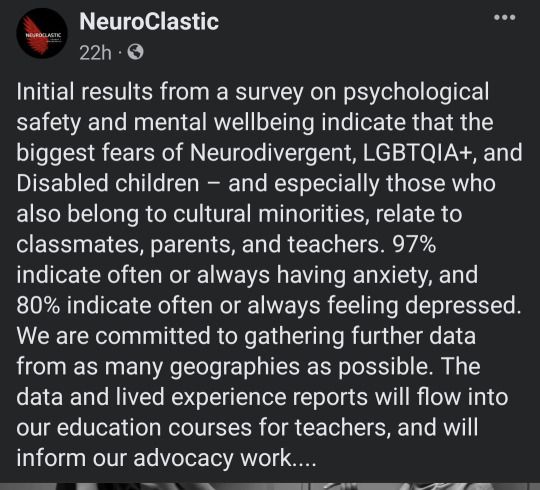
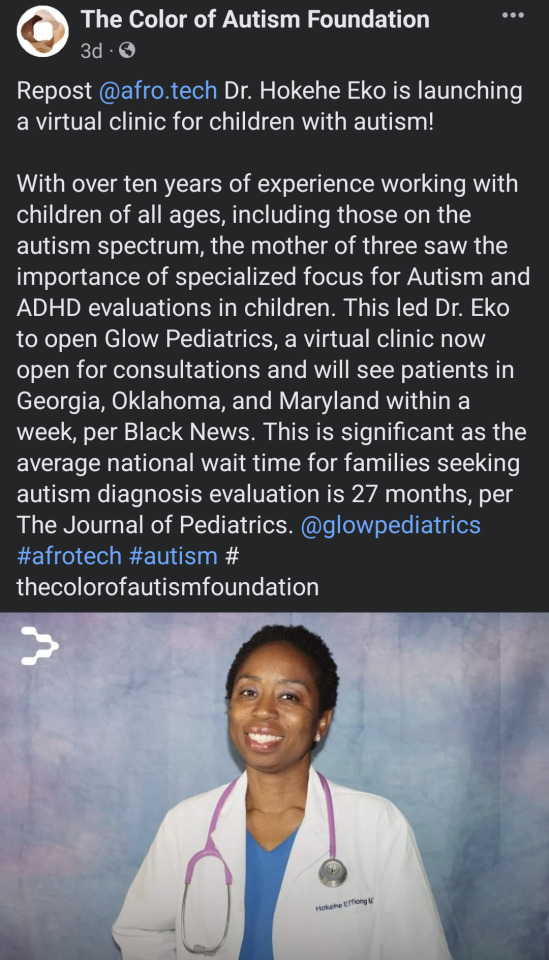
#audhd#autistic adult#actually audhd#autistic pride#autism acceptence month#autism#autism acceptance#asd#autistic
3 notes
·
View notes
Text

In the pre-dawn hours of November 12, 1833, the sky over North America seemed to explode with falling stars. Unlike anything anyone had ever seen before, and visible over the entire continent, an Illinois newspaper reported “the very heavens seemed ablaze.” An Alabama newspaper described “thousands of luminous bodies shooting across the firmament in every direction.” Observers in Boston estimated that there were over 72,000 “falling stars” visible per hour during the remarkable celestial storm.
The Lakota people were so amazed by the event that they reset their calendar to commemorate it. Joseph Smith, traveling with Mormon refugees, noted in his diary that it was surely a sign of the Second Coming. Abraham Lincoln, Frederick Douglass, and Harriet Tubman, among many others, described seeing it. It became known as “The Night the Stars Fell.”
So, what was this amazing occurrence?
Many of those who witnessed it interpreted it as a sign of the Biblical end times, remembering words from the gospel of St. Mark: “And the stars of heaven shall fall, and the powers that are in heaven shall be shaken.” But Yale astronomer Denison Olmsted sought a scientific explanation, and shortly afterwards he issued a call to the public—perhaps the first scientific crowd-sourced data gathering effort. At Olmsted’s request, newspapers across the country printed his call for data: “As the cause of ‘Falling Stars’ is not understood by meteorologists, it is desirable to collect all the facts attending this phenomenon, stated with as much precision as possible. The subscriber, therefore, requests to be informed of any particulars which were observed by others, respecting the time when it was first discovered, the position of the radiant point above mentioned, whether progressive or stationary, and of any other facts relative to the meteors.”
Olmsted published his conclusions the following year, the information he had received from lay observers having helped him draw new scientific conclusions in the study of meteors and meteor showers. He noted that the shower radiated from a point in the constellation Leo and speculated that it was caused by the earth passing through a cloud of space dust. The event, and the public’s fascination with it, caused a surge of interest in “citizen science” and significantly increased public scientific awareness.
Nowadays we know that every November the earth passes through the debris in the trail of a comet known as Tempel-Tuttle, causing the meteor showers we know as the Leonids. Impressive every year, every 33 year or so they are especially spectacular, although very rarely attaining the magnificence of the 1833 event.
The Leonid meteor showers are ongoing now and are expected to peak on November 18. But don’t expect a show like the one in 1833. This year at its peak the Leonids are expected to generate 15 “shooting stars” per hour.
November 12, 1833, one hundred eighty-nine years ago today, was “The Night the Stars Fell.”
The image is an 1889 depiction of the event.
30 notes
·
View notes
Photo
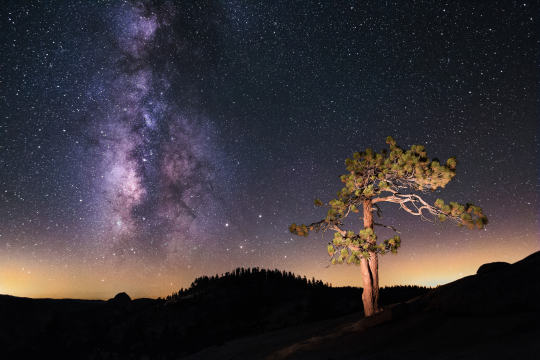
Lone Tree and Milky Way at Olmsted Point by ewoerlen
#500px#Astrophotography#California#Eastern Sierra#Half Dome#Landscape#Milky Way#National Park#Nature
5 notes
·
View notes
Text
starfall

In the pre-dawn hours of November 12, 1833, the sky over North America seemed to explode with falling stars. Unlike anything anyone had ever seen before, and visible over the entire continent, an Illinois newspaper reported “the very heavens seemed ablaze.” An Alabama newspaper described “thousands of luminous bodies shooting across the firmament in every direction.” Observers in Boston estimated that there were over 72,000 “falling stars” visible per hour during the remarkable celestial storm.
The Lakota people were so amazed by the event that they reset their calendar to commemorate it. Joseph Smith, traveling with Mormon refugees, noted in his diary that it was surely a sign of the Second Coming. Abraham Lincoln, Frederick Douglass, and Harriet Tubman, among many others, described seeing it. It became known as “The Night the Stars Fell.”
So, what was this amazing occurrence?
Many of those who witnessed it interpreted it as a sign of the Biblical end times, remembering words from the gospel of St. Mark: “And the stars of heaven shall fall, and the powers that are in heaven shall be shaken.” But Yale astronomer Denison Olmsted sought a scientific explanation, and shortly afterwards he issued a call to the public—perhaps the first scientific crowd-sourced data gathering effort. At Olmsted’s request, newspapers across the country printed his call for data: “As the cause of ‘Falling Stars’ is not understood by meteorologists, it is desirable to collect all the facts attending this phenomenon, stated with as much precision as possible. The subscriber, therefore, requests to be informed of any particulars which were observed by others, respecting the time when it was first discovered, the position of the radiant point above mentioned, whether progressive or stationary, and of any other facts relative to the meteors.”
Olmsted published his conclusions the following year, the information he had received from lay observers having helped him draw new scientific conclusions in the study of meteors and meteor showers. He noted that the shower radiated from a point in the constellation Leo and speculated that it was caused by the earth passing through a cloud of space dust. The event, and the public’s fascination with it, caused a surge of interest in “citizen science” and significantly increased public scientific awareness.
Nowadays we know that every November the earth passes through the debris in the trail of a comet known as Tempel-Tuttle, causing the meteor showers we know as the Leonids. Impressive every year, every 33 year or so they are especially spectacular, although very rarely attaining the magnificence of the 1833 event.
The Leonid meteor showers are ongoing now and are expected to peak on November 18. But don’t expect a show like the one in 1833. This year at its peak the Leonids are expected to generate 15 “shooting stars” per hour.
November 12, 1833, one hundred eighty-nine years ago today, was “The Night the Stars Fell.”
The image is an 1889 depiction of the event.
[A Daily Dose of History]
#A Daily Dose of History#stars#star shower#Tempel-Tuttle#comets#Leonids#Leonid meteor showers#The Night the Stars Fell
13 notes
·
View notes
Text
Trip to See a Wall
Featuring (in order of appearance):
Akina's Umbrella
The Wall (Playing Itself)
Akina

+ All righty, so we've got a day trip to Tokyo planned, curtesy of Akina. We're going to see the inside of a wall, get our wedding rings polished, find some place for lunch, eat some parfaits, and see a special exhibit at the natural history museum. Let's go! The photo above is leaving the apartment and walking to our nearest subway station.

+ Typhoon #13 arrived a couple days ago and today was the trailing end of it, so it was drizzling a bit in the morning. Here is one of the main streets through Wakoshi/Narimasu (our area). Pink umbrella contains the wife.

+ The subway ride takes about 40 minutes to get to very central Tokyo and a transfer; here's that transfer happening, in the guts of Tokyo proper. People here walk noticeably faster than in the North Olmsted of Japan. There's signs here explaining to walk on the left and generally everyone follows them.

+ Back to our old apartment area! Here's standing at the big temple looking east towards Daimon. We're on our way to see the inside of a wall.
+ Okay, so in explanation. Very close to our old apartment is a big, important temple called Zōjōji. I've talked about it a lot; it's where Abe's funeral was, etc.
+ Anyways, back in the day (couple hundred years), the temple grounds were much more extensive than today, but some of the original walls from that time still exist. So a few months ago Akina and I noticed something happening at one of the buildings and stopped by. The idea is that one of these walls needed to be opened up a bit to make room for some modern construction work and it would present the first/only opportunity for people to see the inside of the wall. Thinking it'd be in a few weeks, we signed-up to be notified.
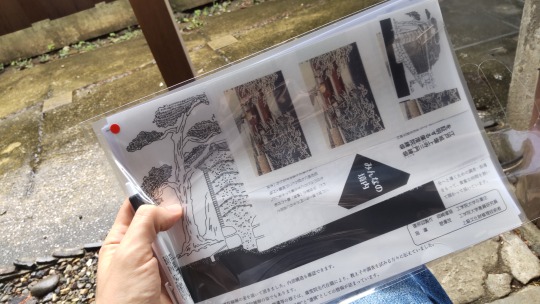
+ That was months ago. We were finally notified and decided to return to make a day trip of it. They give you a big informational packet about this wall and a free can of tea.
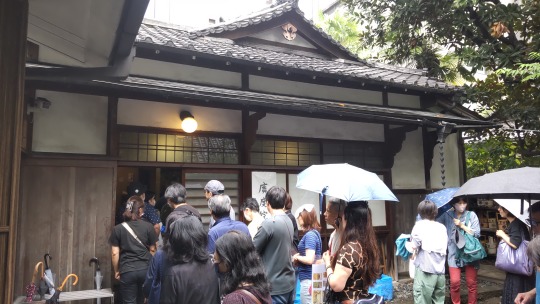
+ So we all crowd into this building...

+ To sit through a one-hour lecture by a professor who knows about walls.
+ I'mma only going to say positive things:
It was good Japanese-listening practice
It reminded me of sitting in a college lecture, something I miss
I was all the way in the back without a chair and it was very comfortable to just relax in the dark for an hour

+ Our mistaken belief was that we'd signed up for the the opportunity to see the inside of the wall. In reality, the wall is just outside, right around the corner. Literally anyone can look at it. Akina's off there on the side demonstrating how she feels about this.

+ Anyways... with that accomplished, we stopped by Zōjōji to see what three months of construction work resulted in. Turns out nothing. They took my rest spot from me for three months for absolutely nothing. Thanks.


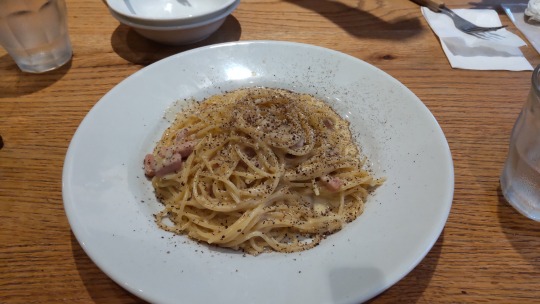
+ Right, so then we dropped off our rings at the wedding ring place and found an Italian lunch place down the street. The pizza was really good; the pasta had way, way too much pepper.


+ Outside lunch is the only time I drink coffee; the one on the left was mine (straight) the one on the right is Akina's after she messed it up by putting cream and all the sugar in, distorting it into something undrinkable, a grotesque distortion of its former self. The photos serve as reference not to do this.

+ Here's Italia Street, where our wedding ring place is located; it's Italian themed
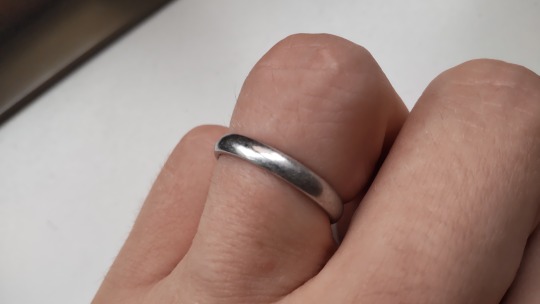

+ And here's the complementary ring polish. Left: before; right: after. Actually, I think that's Akina's hand on the right?

+ So a short subway hop over to Asakusa, a major touristy area filled with shops and famous for a big temple/shrine. Many of the sidewalks are covered like this (with roofs) and there's lots of foreigners.
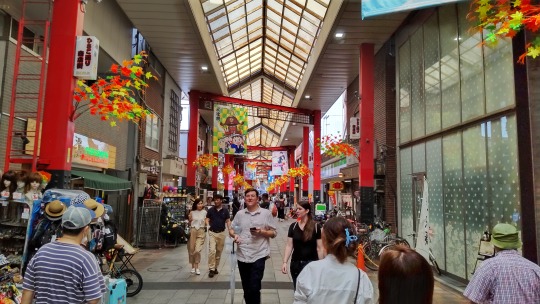
+ But our destination is this covered shopping street. You've seen plenty of these before, they're common.
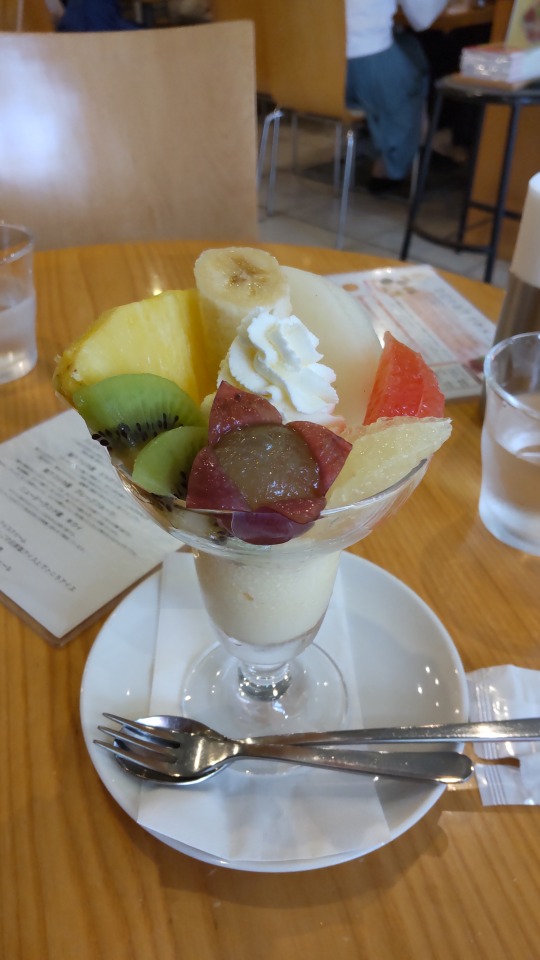
+ Parfait. It wasn't bad, but it wasn't super special. Subtracted points for no crunchy texture inside and no secret waiting in the bottom.
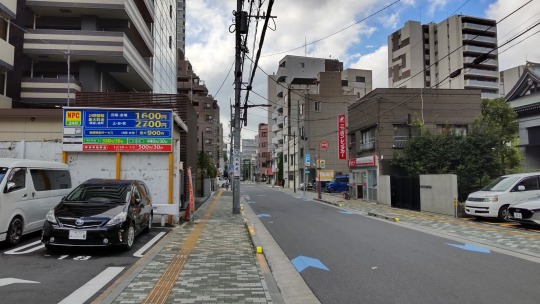
+ With our parfaits eaten, we're walking over to Ueno now to get to the museum. We have a one-year pass to the museum which allows unlimited free visits to the normal rooms, but this time there's a special exhibit. The blue arrows on the road are from recently revised government guidelines dictating road markers for bicycle traffic.
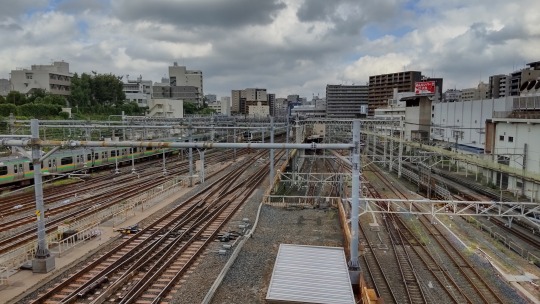
+ Ueno is a major train station so there's lots of train lines here; with that typhoon that just past, today was the first (and only) day in about a month that wasn't over 90°F.

+ The special exhibit was about the ocean. Akina and I have decided these special exhibits are not worth it. On the weekends there's way too many people, but more importantly, we never learn anything from them.
The ocean is really big. Plankton is really small. It's the bottom of the food chain. There's weird things in the ocean. Humans are literally destroying every part of it.
+ Yuup...

+ The museum itself is very large, too much for a single day, so the free pass allows us to spend time checking out things we haven't see before... There's a whole floor on dinosaurs I've never seen...

+ Rocky River! You're world famous!
+ So this (like the hundreds of casts of it around the world), is of specimen CMNH 5768... the largest fossil ever found of Dunkleosteus terrelli, a uniquely Ohio treasure. The first fossils discovered were along the Olentangy River between Columbus and Delaware, but the biggest and most complete come from the Rocky River Valley. The largest of these, CMNH 5768, is in the Cleveland Museum of National History (CMNH), but every replica across the globe (including this one in Tokyo) is of that specimen. In 2020, SB 123 made Dunkleosteus the state fossil of Ohio. I've seen about a dozen or more of these all over.

+ This section also had some of the most ridiculous fossils I've ever seen... This one is perfectly preserved in three dimensions... Who the hell spent the time chipping away at that, without breaking it?
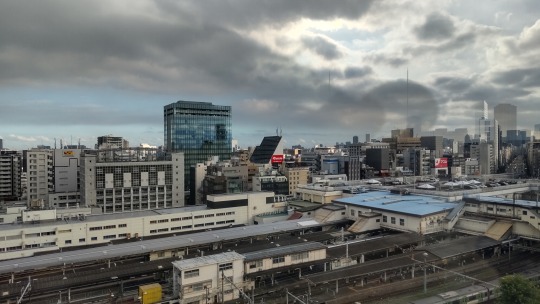
+ The top of the museum has an "herb garden" with only rosemary. There's also an observation deck. This is looking south-east across Ueno.

+ Anyways, that's all for today, making a quick subway transfer in Ginza (you have to walk on the street to transfer, it's weird). You've see this before, it's the fancy shopping district of Tokyo.

+ And we're back... Hope y'all enjoyed.
2 notes
·
View notes
Text
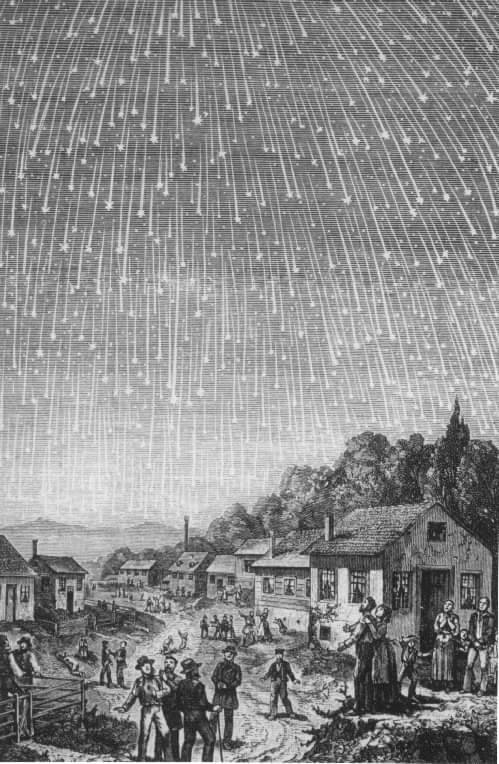
In the pre-dawn hours of November 12, 1833, the sky over North America seemed to explode with falling stars. Unlike anything anyone had ever seen before, and visible over the entire continent, an Illinois newspaper reported “the very heavens seemed ablaze.” An Alabama newspaper described “thousands of luminous bodies shooting across the firmament in every direction.” Observers in Boston estimated that there were over 72,000 “falling stars” visible per hour during the remarkable celestial storm.
The Lakota people were so amazed by the event that they reset their calendar to commemorate it. Joseph Smith, traveling with Mormon refugees, noted in his diary that it was surely a sign of the Second Coming. Abraham Lincoln, Frederick Douglass, and Harriet Tubman, among many others, described seeing it. It became known as “The Night the Stars Fell.”
So, what was this amazing occurrence?
Many of those who witnessed it interpreted it as a sign of the Biblical end times, remembering words from the gospel of St. Mark: “And the stars of heaven shall fall, and the powers that are in heaven shall be shaken.” But Yale astronomer Denison Olmsted sought a scientific explanation, and shortly afterwards he issued a call to the public—perhaps the first scientific crowd-sourced data gathering effort. At Olmsted’s request, newspapers across the country printed his call for data: “As the cause of ‘Falling Stars’ is not understood by meteorologists, it is desirable to collect all the facts attending this phenomenon, stated with as much precision as possible. The subscriber, therefore, requests to be informed of any particulars which were observed by others, respecting the time when it was first discovered, the position of the radiant point above mentioned, whether progressive or stationary, and of any other facts relative to the meteors.”
Olmsted published his conclusions the following year, the information he had received from lay observers having helped him draw new scientific conclusions in the study of meteors and meteor showers. He noted that the shower radiated from a point in the constellation Leo and speculated that it was caused by the earth passing through a cloud of space dust. The event, and the public’s fascination with it, caused a surge of interest in “citizen science” and significantly increased public scientific awareness.
Nowadays we know that every November the earth passes through the debris in the trail of a comet known as Tempel-Tuttle, causing the meteor showers we know as the Leonids. Impressive every year, every 33 year or so they are especially spectacular, although very rarely attaining the magnificence of the 1833 event.
The Leonid meteor showers are ongoing now and are expected to peak on November 18. But don’t expect a show like the one in 1833. This year at its peak the Leonids are expected to generate 15 “shooting stars” per hour.
November 12, 1833, one hundred eighty-nine years ago today, was “The Night the Stars Fell.”
The image is an 1889 depiction of the event.
photo : A Daily Does Of History
youtube
8 notes
·
View notes
Photo

Two Giants
What do you think about my pic?
#Olmsted Point#Half Dome#El Capitan#Yosemite National Park#California#granite#Sierra Nevada#mountains#woods#forest#pine#fire#tree#flora#original photography#landscape#countryside#blue sky#clouds#USA#West Coast#tourist attraction#landmark#summer 2022#photo of the day#What do you think about my pic?
11 notes
·
View notes
Photo
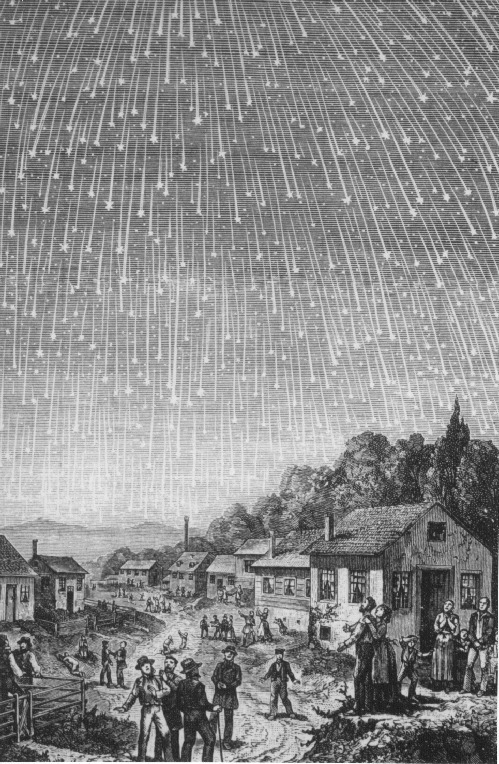
From A Daily Dose of History on Facebook:
In the pre-dawn hours of November 12, 1833, the sky over North America seemed to explode with falling stars. Unlike anything anyone had ever seen before, and visible over the entire continent, an Illinois newspaper reported “the very heavens seemed ablaze.” An Alabama newspaper described “thousands of luminous bodies shooting across the firmament in every direction.” Observers in Boston estimated that there were over 72,000 “falling stars” visible per hour during the remarkable celestial storm.
The Lakota people were so amazed by the event that they reset their calendar to commemorate it. Joseph Smith, traveling with Mormon refugees, noted in his diary that it was surely a sign of the Second Coming. Abraham Lincoln, Frederick Douglass, and Harriet Tubman, among many others, described seeing it. It became known as “The Night the Stars Fell.”
So, what was this amazing occurrence?
Many of those who witnessed it interpreted it as a sign of the Biblical end times, remembering words from the gospel of St. Mark: “And the stars of heaven shall fall, and the powers that are in heaven shall be shaken.” But Yale astronomer Denison Olmsted sought a scientific explanation, and shortly afterwards he issued a call to the public—perhaps the first scientific crowd-sourced data gathering effort. At Olmsted’s request, newspapers across the country printed his call for data: “As the cause of ‘Falling Stars’ is not understood by meteorologists, it is desirable to collect all the facts attending this phenomenon, stated with as much precision as possible. The subscriber, therefore, requests to be informed of any particulars which were observed by others, respecting the time when it was first discovered, the position of the radiant point above mentioned, whether progressive or stationary, and of any other facts relative to the meteors.”
Olmsted published his conclusions the following year, the information he had received from lay observers having helped him draw new scientific conclusions in the study of meteors and meteor showers. He noted that the shower radiated from a point in the constellation Leo and speculated that it was caused by the earth passing through a cloud of space dust. The event, and the public’s fascination with it, caused a surge of interest in “citizen science” and significantly increased public scientific awareness.
Nowadays we know that every November the earth passes through the debris in the trail of a comet known as Tempel-Tuttle, causing the meteor showers we know as the Leonids. Impressive every year, every 33 year or so they are especially spectacular, although very rarely attaining the magnificence of the 1833 event.
The Leonid meteor showers are ongoing now and are expected to peak on November 18. But don’t expect a show like the one in 1833. This year at its peak the Leonids are expected to generate 15 “shooting stars” per hour.
November 12, 1833, one hundred eighty-nine years ago today, was “The Night the Stars Fell.”
The image is an 1889 depiction of the event.
From The Irish Times:
In Maury County, Tennessee, a small girl, born into slavery, was awoken in her cot by the sound of screaming.
The story of Amanda Young, who died in 1920, was recounted in 2010 by her great-great granddaughter Angela Y Walton-Raji as part of a family oral history. Walton-Raji had travelled to Chicago to meet her own elderly cousin, Frances Swader, and to hear from her Young’s story.
Walton-Raji reported Young’s words thus: “Somebody in the quarters started yellin’ in the middle of the night to come out and to look up at the sky. We went outside and there they was a-fallin’ everywhere!
“Big stars coming down real close to the groun’ and just before they hit the ground they would burn up! We was all scared. Some o’ the folks was screamin’, and some was prayin’. We all made so much noise, the white folks came out to see what was happenin’. They looked up and then they got scared, too.
“But then the white folks started callin’ all the slaves together, and for no reason, they started tellin’ some of the slaves who their mothers and fathers was, and who they’d been sold to and where. The old folks was so glad to hear where their people went. They made sure we all knew what happened … you see, they thought it was Judgement Day.”
7 notes
·
View notes
Photo

Layers. Olmsted Point. Yosemite NP CA. [2827x3533] [OC]
4 notes
·
View notes

